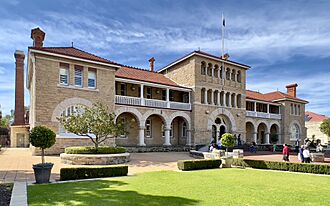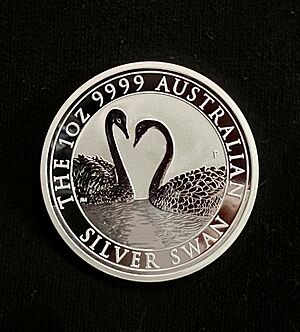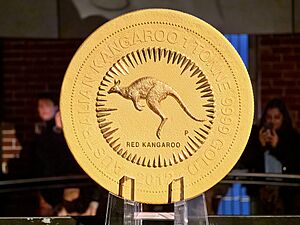Perth Mint facts for kids
The Perth Mint is Australia's official place for making gold and silver bars and coins. It is fully owned by the Government of Western Australia. The Mint started on 20 June 1899. This was two years before Australia became a united country in 1901.
The Perth Mint was one of three branches of the United Kingdom's Royal Mint in Australia. Its main job was to refine gold from the Australian gold rushes and make gold coins called gold sovereigns and half-sovereigns for the British Empire. Today, the Perth Mint and the Royal Australian Mint (which makes coins for everyday use) are Australia's two mints that create legal tender coins.
| Headquarters | 310 Hay Street, East Perth,
Perth, Western Australia
,
Australia
|
|---|---|
|
Key people
|
|
| Revenue | A$25,373,999,000 (2024) |
| Owner | Government of Western Australia |
|
Number of employees
|
749 (2024) |
| Parent | Gold Corporation |
|
Building details
|
|

Perth Mint
|
|
| General information | |
| Location | Hay Street, East Perth, Western Australia |
| Coordinates | Lua error in Module:Coordinates at line 614: attempt to index field 'wikibase' (a nil value). |
| Opened | 20 June 1899 |
| Design and construction | |
| Architect | George Temple-Poole |
| Type | State Registered Place |
| Designated | 15 December 2000 |
| Reference no. | 2166 |
| Footnotes / references Fiscal Year 2024 (FY24) is 1 July 2023 to 30 June 2024. Source: Annual Report |
|
Contents
History of the Perth Mint
The Perth Mint started as a branch of the Royal Mint in the United Kingdom during the 1890s. The first stone for the Mint building was laid in 1896. The building officially opened on 20 June 1899.
At that time, many people were moving to Western Australia (WA). This was because a lot of gold had been found in places like Coolgardie and Kalgoorlie.
Early Purposes of the Mint
The Mint had two main jobs at first. One was to make coins for use in WA. Before this, coins were made elsewhere, and there often weren't enough.
The second job was to buy most of the gold mined in WA. Many gold miners, called "diggers," came to WA. They could sell their raw gold directly to the Mint. The Mint then turned this gold into coins and bullion (pure metal bars).
Changes in Ownership and Production
Even though WA joined the Federation of Australian colonies in 1901, the UK government controlled the Mint for another 69 years. On 1 July 1970, the government of Western Australia took over the Mint. It became a statutory authority, which means it was set up by law.
Up until 1931, the Perth Mint made over 106 million gold sovereigns. These were used as money in Australia and across the British Empire. The Mint stopped making gold sovereigns when Britain no longer used the gold standard in 1931. However, the Mint's refinery kept busy making fine gold bars.
During World War II, the Perth Mint started making Australian coins from other metals. Until the end of 1983, the Perth Mint also made many of Australia's smaller coins.
Achieving Pure Gold Standards
In 1957, the Perth Mint made gold that was incredibly pure. It was almost 99.999% pure gold. This was so impressive that the Royal Mint in the UK ordered some of this gold to use as a standard for their own gold.
New Direction and Global Sales
The Mint's new direction began in 1987 with the creation of Gold Corporation. This was set up by a State law. The Perth Mint was then allowed to make and sell gold, silver, and platinum coins that were legal tender in Australia. These coins were sold to investors and collectors around the world.
In 1987, Prime Minister Bob Hawke launched the Australian Nugget Gold Coins Series. On the first day, the Mint sold about 155,000 ounces of gold. This was worth about A$103 million at the time.
By the year 2000, the Perth Mint had refined a huge amount of gold. This was about 3.25% of all the gold ever produced by humans. This amount is similar to the gold stored at Fort Knox in the United States.
In 2003, the Perth Mint opened a new, modern manufacturing building. It is located right next to its original limestone building.
World's Largest Gold Coin
In October 2011, the Perth Mint made the world's largest, heaviest, and most valuable gold coin. This coin is about 80 centimeters (31 inches) wide and 12 centimeters (4.7 inches) thick. It is made from 1,012 kilograms (2,231 pounds) of 99.99% pure gold.
One side of the coin shows the image of Elizabeth II. The other side features a red kangaroo. This coin is legal tender in Australia with a face value of A$1 million. However, when it was made, its gold value was about A$53.5 million.
Today, the Perth Mint continues to refine metals and make many special coins for investors and collectors. It makes most of Australia's legal tender precious metal coins. These include proof quality Australian Nugget gold coins, Australian Platinum Koala coins, Australian Silver Kookaburra coins, and Swan series coins.
As of November 2019, the Perth Mint refines about 79% of the gold produced in Australia and nearby areas. It also refines 30% of the world's silver at a separate secure location. The Mint makes coins and bars from both Australian gold and metal from other countries. This represents 10% of the world's total production. In 2018, it sold about A$18.9 billion worth of pure gold, silver, and platinum bars and coins.
Digital Gold Assets
The Perth Mint Gold Token (PMGT) was a type of digital asset available from 2019 to 2023. It was offered by a company called Trovio, which used the Perth Mint's name. Each PMGT was linked to actual gold held at the Perth Mint. This digital token was stopped in late 2023.
GoldPass was a phone app launched by the Perth Mint in 2018. The app allowed people to buy, sell, and trade digital certificates. These certificates represented physical gold or silver stored at the Perth Mint.
Gold Discovery Trail
In October 2018, a group called the Gold Industry Group started a Heart of Gold Discovery Trail in Perth. The Perth Mint was one of the partners in this project.
See also
- Bullion coin
- Gold as an investment
- History of Western Australia
- Inflation hedge
- Perth Mint Swindle
- Silver as an investment




